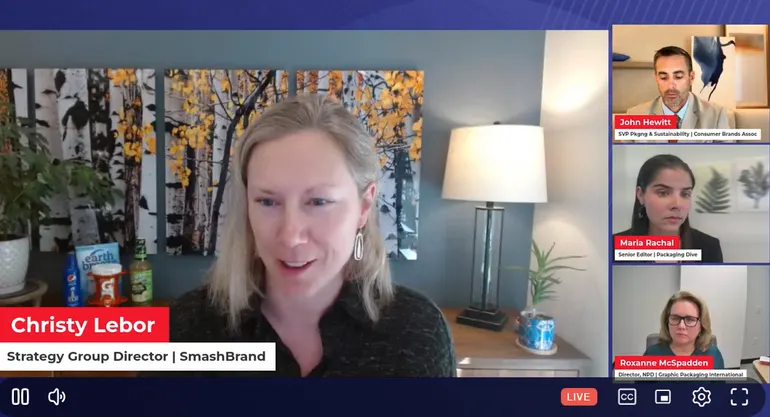Table of Contents
Editor’s note: This article covers insights from a recent event hosted by Packaging Dive and Food Dive. If you missed the event, you can watch the replay on demand here.
For many consumer packaged goods (CPG) companies, designing food packaging is a delicate balance between convenience, shelf appeal, and adherence to new recyclability regulations.
During The Future of Food & Packaging Innovation event on Oct. 15, speakers from the Consumer Brands Association, SmashBrand, and Graphic Packaging International discussed the latest trends in food packaging innovation.
John Hewitt, senior vice president of packaging and sustainability for the Consumer Brands Association, emphasized the challenge of meeting regulatory requirements while also delivering products safely and effectively to consumers.
With seven states in the U.S. adopting extended producer responsibility for packaging laws, brands are facing significant changes in their packaging designs and budgeting strategies.
Hewitt highlighted the importance of EPR in driving investment in recycling infrastructure and helping companies achieve their circularity goals through incorporating recycled content into packaging.
He noted the complexity of managing multiple sets of recycling rates, rules, and compliance policies across different states, estimating that nearly 20% of the U.S. population will be impacted by EPR laws.
Furthermore, EPR-related regulations like ecomodulation add another layer of complexity, as companies may need to switch to more sustainable packaging materials to reduce fees.
Strategies for Sustainability Goals
Major CPG brands are reevaluating their sustainability goals, with some making progress while others adjust their targets due to challenges in local recycling systems.
Roxanne McSpadden from Graphic Packaging International highlighted the growing demand for lifecycle assessments to understand the full impact of packaging beyond traditional metrics like plastic reduction.
While recyclability remains a priority, McSpadden emphasized the benefits of paper-based packaging as a renewable resource with high recycling potential.
Balancing Sustainability and Shelf Appeal
CPG companies are exploring creative solutions to make packaging more sustainable while maintaining visual appeal on store shelves.
Christy Lebor from SmashBrand suggested incorporating messaging into packaging to communicate environmental benefits to consumers, driving market success.
She noted that consumers respond positively to messages highlighting reduced plastic usage or waste, indicating a shift towards more eco-conscious purchasing decisions.
McSpadden added that suppliers can play a crucial role in helping companies navigate sustainability changes by sharing insights on materials and components that meet environmental regulations.

